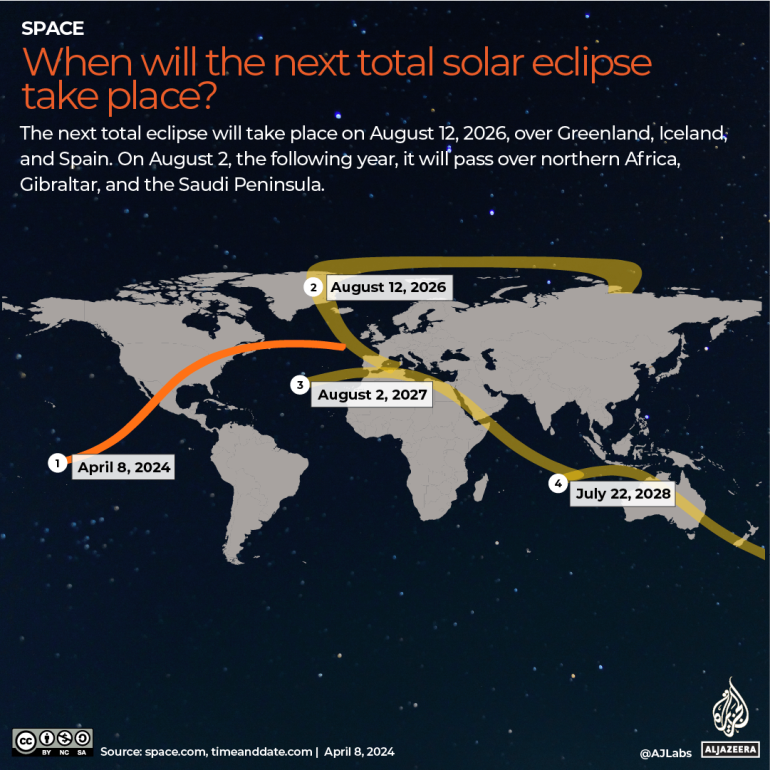Millions of people across North America will get the chance to experience a very special natural event on Monday when a total solar eclipse will be visible from parts of Mexico, the United States and Canada.
The total eclipse – which occurs when the moon completely blocks out the sun – will darken skies for a few minutes “as if it were dawn or dusk”, the US’s NASA space agency explains.
It will be visible from a 185km-wide (115 mile-wide) band that stretches from the western coast of Mexico, through the US, and up to Canada’s easternmost province of Newfoundland and Labrador – what’s known as the “path of totality”.
“Weather permitting, people along the path of totality will see the sun’s corona, or outer atmosphere, which is usually obscured by the bright face of the sun,” NASA says on its website.
The path of totality is really “where it’s at” on Monday, said Anthony Aveni, professor emeritus at Colgate University in New York and author of the book, In the Shadow of the Moon: The Science, Magic, and Mystery of Solar Eclipses.
“It’s that precious three minutes or so … of totality when you see a whole range of phenomena that you just don’t see in everyday life,” he told Al Jazeera. “It takes your breath away and you stop what you’re doing and gawk at nature.”
So how often do total solar eclipses occur? How long does it typically last? Where and how can you watch safely? Here’s everything you need to know.
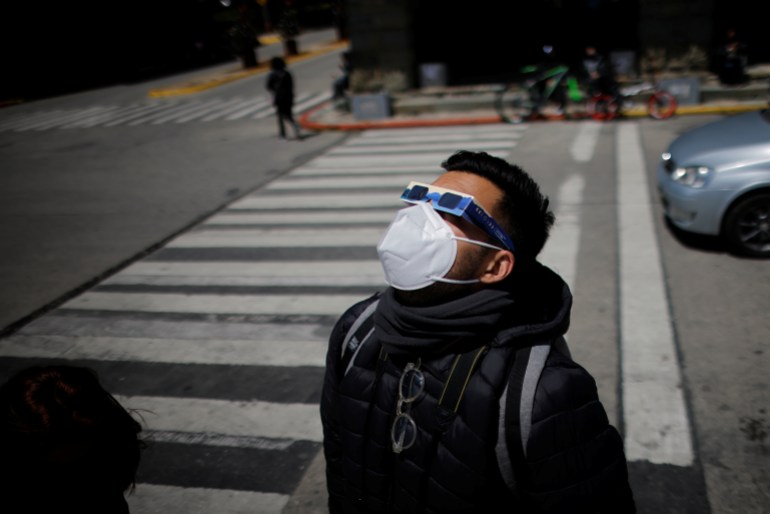
Where will the total eclipse be visible from, and at what time?
Monday’s total eclipse will be visible from parts of Mexico, the US and Canada.
It will enter continental North America in Mazatlan, in the northwestern Mexican state of Sinaloa, at 11:07am local time (18:07 GMT). It will exit the continent on the Atlantic coast of Newfoundland, Canada, at 5:16pm local time (19:46 GMT).
In the US, the eclipse will enter the state of Texas at 1:27pm local time (18:27 GMT) and exit in Maine at 3:35pm local time (19:35 GMT).
It will last only a few minutes, and the exact time it will be visible depends on where you are within the path of totality.
For example, in Erie, Pennsylvania, totality starts at 3:16pm local time (19:16 GMT) and ends at 3:20pm (19:20 GMT).
It will reach Buffalo, New York, a few minutes later: there, totality starts at 3:18pm local time (19:18 GMT) and ends at 3:22pm (19:22 GMT).
A partial eclipse also will be visible for about two hours on Monday, before and after totality.
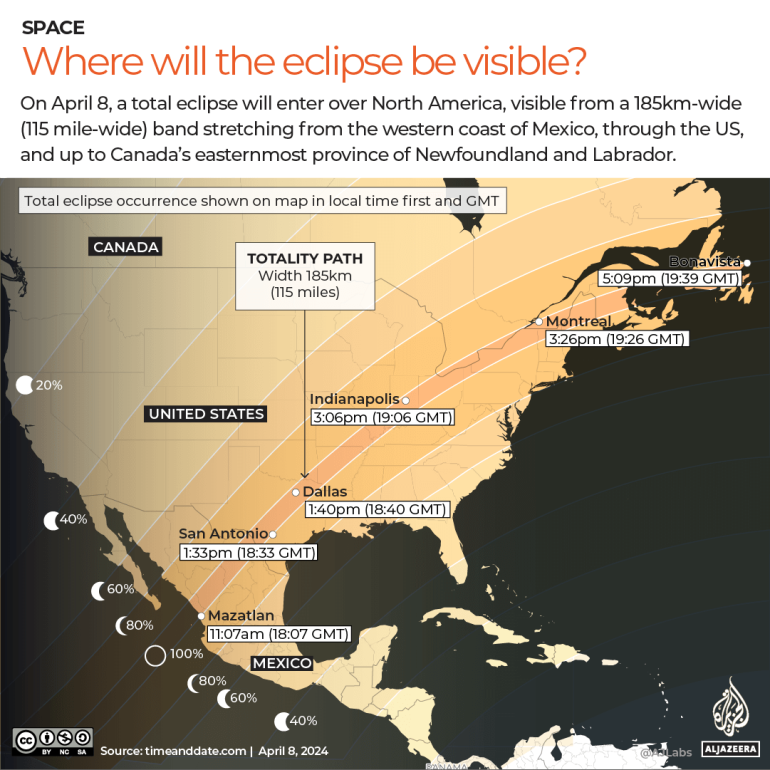
What happens during a total solar eclipse?
While the Earth and moon both orbit the sun, the moon also circles the Earth each month.
During a total solar eclipse, the moon passes directly between the sun and the Earth, completely blocking the sun’s light on one side, and casting a shadow on a small area of Earth on its other side.
The dark inner part – the “umbra” – of this shadow creates a narrow track or “path” as the moon orbits the Earth. Areas on this path, and especially on its centreline, which fall directly under the shadow, are the ones from where the total eclipse will be visible.
This track is about 160km (100 miles) wide and 16,000km (10,000 miles) long.
“If it was a lunar eclipse, it would last for a few hours and people around the world could see it. But the difference is that total eclipses only happen over a specific path of that new moon,” said Khady Adama Ndao, a NASA eclipse ambassador.
This eclipse only occurs during a new moon. And the moon’s position in its orbit, relative to the sun and Earth, as well as the angles of all three at a specific time, are what create a total eclipse.
While the moon will be close enough to Earth so as to look as though it entirely covers the sun during an eclipse, in reality the moon is 400 times smaller than the sun. It’s the increased distance between the moon and the sun at the time of a total eclipse that makes the moon look like it is big enough to cover the sun.
Meanwhile, people who are close to the path of totality, but not directly in it, may see what’s known as a partial eclipse on Monday. That’s when only a part of the sun is obscured by the moon.
Areas from which a partial eclipse will be visible fall under faint parts of the moon’s wider shadow, called the “penumbra”.
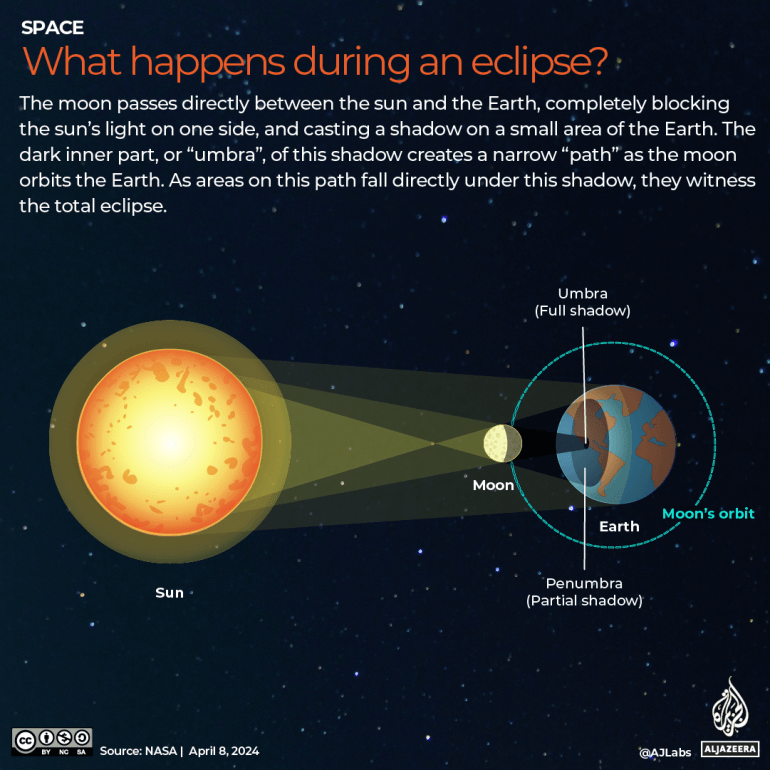
What does a total eclipse look like?
As the moon moves past the sun during an eclipse, it will slowly obscure the sun – creating a dark sky – before reaching the moment of “totality”. That’s when almost the entirety of the sun will be covered, leaving only a faint circle of the sun’s light or the corona.
After a few minutes, people in the path of totality will see a partial eclipse again as the moon moves away. The sun will become fully visible again.
What else happens during the moment of totality?
There is a drop in temperature and animals also start to behave as if it’s nighttime.
The chirping patterns of birds may change, while nocturnal animals such as bats and owls may start to wake up and look for prey.
Stars and celestial objects hanging in the dark sky may also become more visible.
If a person were to stand on the moon or a space station orbiting Earth, they would also be able to see a dark shadow passing over the Earth.

How long will the total solar eclipse last on April 8?
A total solar eclipse can last between two to three hours, from the moment the moon first begins to cover the sun, until the time the moon crosses past the sun and stops obscuring it.
However, the period of totality in most places this year will last only between three and a half to four minutes.
Areas on and very close to the centreline will experience the longest period of totality while totality will last for shorter periods of time in areas farther from the centreline.
The longest period of totality on Monday – 4 minutes and 28 seconds – will occur near Torreon, Mexico. That’s because the area is closest to the point at which the shadow’s path is perpendicular to the Earth’s surface and near the central line of the umbral shadow.
In the past, totality in some places has lasted for as little as a few seconds, and as long as seven and a half minutes.
The durations of the eclipse and the period of totality differ due to a combination of factors, such as the curvature of the Earth and angle at which the moon’s shadow strikes.
Mobile applications such as “Totality” track eclipse start and end times, as well as totality durations for different cities on the total eclipse’s path.
What are some of the cultural and historical beliefs around total solar eclipses?
Total solar eclipses have captivated people for thousands of years. But in ancient civilisations, the phenomenon was often viewed as a bad omen.
In ancient China, for example, people believed that solar eclipses happened because “a celestial dragon” was eating the sun, according to NASA. As a result, people made loud noises during eclipses “to frighten the dragon away”.
The Inca people of South America believed solar eclipses were a sign of the sun god Inti’s anger.
And in ancient Mesopotamia (modern-day Iraq), a solar eclipse was thought to signal that the ruler was in grave danger – leading decision-makers to put a system in place known as the “substitute king”.
In order to prevent the real Assyrian king, for example, from being harmed, a substitute would be dressed up and ultimately offered as a sacrifice “for the evil fate that was destined for the true king”, explained Sarah Graff, a curator in the Department of Ancient Near Eastern Art at the Metropolitan Museum of Art in New York City.
According to Aveni at Colgate University, there is a tendency to view people in the past as being less intelligent or more superstitious about eclipses than people today. “But in every case, it’s an occasion to have a conversation,” he told Al Jazeera.
For instance, people made noise in the ancient Andean world during an eclipse “to alert the sun not to believe what the moon is whispering in his ear, which is that we people that live down here on Earth do bad things at night”, Aveni said. “This becomes an occasion to have a discussion about lying – that’s really what it’s about.”
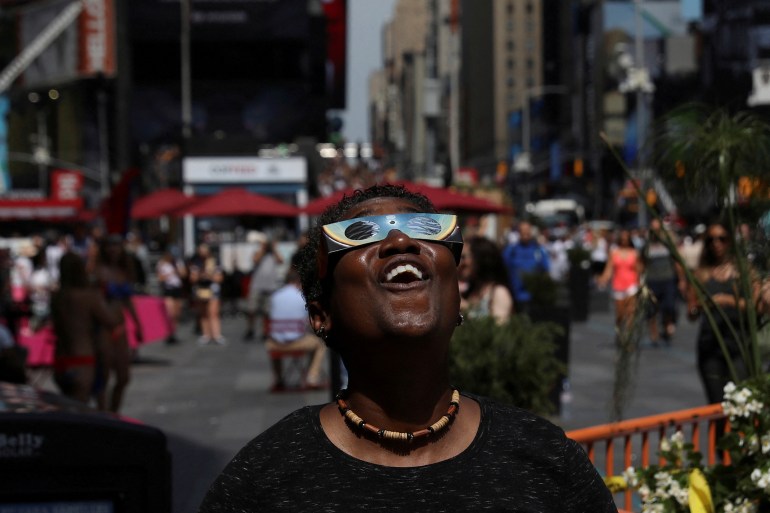
Can you watch a total solar eclipse without glasses?
Experts stress that safety is critical.
During the brief time in which the moon completely blocks out the sun, people can view the total eclipse with their naked eye.
But during the partial eclipse before and after totality, you should use specially designed, protective solar glasses or a handheld solar viewing device.
“If people look without the proper protection, they run the risk of injuring their eyes,” said B Ralph Chou, president of the Royal Astronomical Society of Canada.
“And if they get an injury, depending on how often and how long they look at the sun without the protection, they do have a substantial risk of developing a permanent loss of vision.”
This risk is due to a number of factors such as the intensity and radiation of the sun’s light, as well as the absence of pain receptors in the eye, which makes it easier to stare for too long.
Compared with a regular day, pupils may also be less dilated during an eclipse, making the bright light that enters more dangerous. “It’s like being in the dark, when all of a sudden, someone just flashes a flashlight in front of your eyes”, Ndao, the NASA eclipse ambassador, said.
How are people preparing?
Cities and towns across the path of totality have been distributing eclipse glasses to residents in the weeks leading up to Monday’s event. Museums, science centres and other institutions are holding viewing parties.
Schools in the US and Canada have announced closures on Monday to allow students to participate in eclipse-watching events. The closures also aim to avoid safety issues, as schools have raised concerns that the total eclipse coincides with school dismissal times.
Groups of people are also flying in private planes to watch the totality, said Barbara Gruber, assistant director of education and public outreach at the National Radio Astronomy Observatory (NRAO) in the US.
While this is permitted, the US Federal Aviation Authority has put out safety advisories about flying during totality.
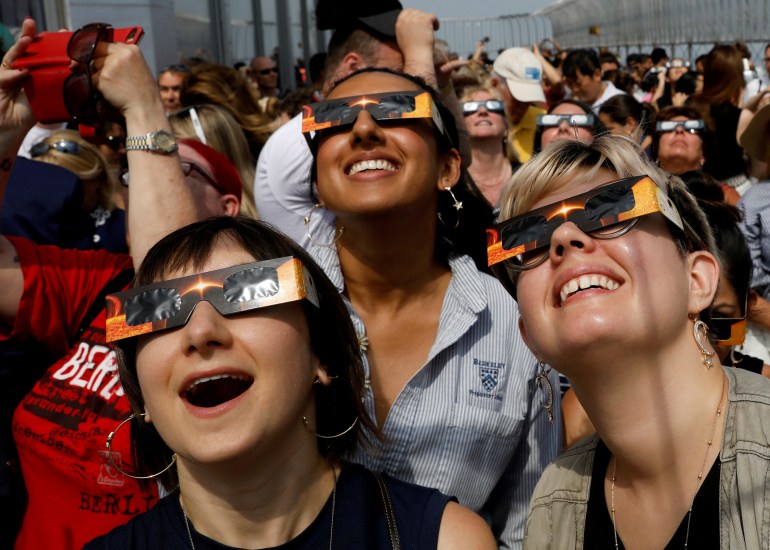
Are you guaranteed to see the total eclipse if you’re in the path of totality?
Unfortunately not. Weather conditions will play an important factor in what hopeful eclipse-watchers will be able to see on Monday.
In other words, if it’s cloudy, that could ruin the visibility.
If you’re not in North America, several institutions will be hosting live coverage of the total eclipse, including NASA.
How often does a total solar eclipse happen?
While Monday may be the last time the US sees an eclipse for at least another nine years, a total solar eclipse generally occurs every 18 months.
Many total eclipses are only visible at sea and may not be seen by anyone at all, according to Ndao.
Additionally, once a particular area experiences a total eclipse, it may not see the return of the phenomenon for hundreds of years.
“On average a single location will experience a total solar eclipse about every 350 years, but averages can be misleading and some lucky places will get an eclipse in just a few years”, Gruber told Al Jazeera.
When is the next total solar eclipse?
The next total solar eclipse will take place on August 12, 2026, over Greenland, Iceland, and Spain. Almost exactly a year later, on August 2, 2027, one will be visible from northern Africa, Gibraltar, and the Saudi peninsula.
In the US, the next total eclipse will occur in 2033 but will only be visible from Alaska.
Western Canada, Montana and North Dakota will witness a total eclipse in 2044 and, the following year, people in the US will be able to see a total eclipse from coast to coast, according to NRAO.
Experts say a day will come, however, when total eclipses will stop occurring altogether – but not for quite a while.
As the universe expands with the moon moving further away from the Earth each year, and the sun gets bigger, the moon will eventually become too small in the sky to block the whole sun.
That day is still a distant reality though. A NASA study in 2017 estimated that total eclipses would end in 563 million years.
